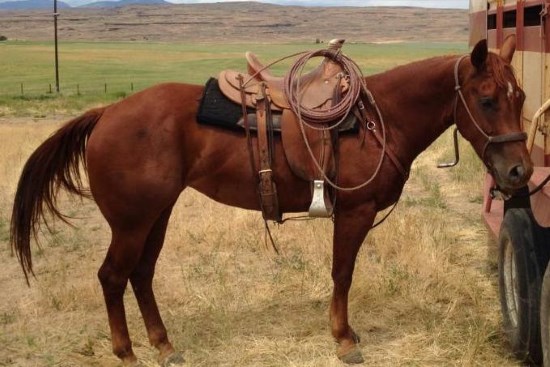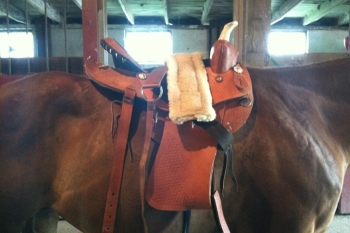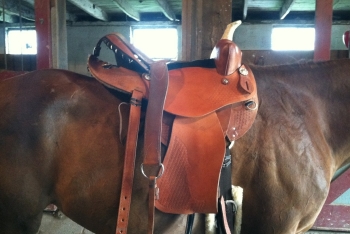Why does my saddle lift up at the back? Part three
We are no longer building saddle trees, but we have two videos about how Western saddles fit horses available on our westernsaddlefit.com website.

In the first part of this series we talked about the three most common causes that a saddle will lift up at the back – too wide a bar spread, too wide a bar angle and too much rock in the bar for the horse. In the second part we looked at another couple causes – too narrow an angle at the middle of the bar and a rigging that is set way too far forward. So, with all these options, how can you tell which is the cause in a specific case? Here’s a few things you can do to test it out. (I just have to point out that this saddle is too far forward on the horse – up on his shoulder blades when it should be behind them.)
First, set the saddle on the horse - in the correct position!! ( front bar tip behind the shoulder blade) - and step back. Is it falling down in front now?
If yes, then excess width, either spread or angle, at the front may be the problem, or conversely, too little angle in the center may be the problem. It may possibly be too much rock as well depending on how the saddle is built.
If not, then too much rock or a too forward rigging position are more likely to be involved.
Next, try to rock the saddle front and back by pushing down on the horn and cantle alternately.
Can you rock it back and then it falls forward on its own? Are you not able to rock it forward more than it already is? Then you are probably looking at excess width of some kind.
Does it rock both forward and back? If so, then it is rocking around the center of the bar, so excess rock or too narrow an angle at the middle will be higher on the list.
Does it not rock at all when trying this test? Then it is most likely rigging position, unless it isn’t really lifting off the horse at the back at all.
Now, feel under the saddle. Where are the bars contacting the horse?
Are the bars actually lifted off the horse at the back? If not, then you have something mimicking the problem, or a too forward rigging causing a “problem” the tree doesn’t have on its own.
How much of the back of the tree is off the horse? How far forward can you feel before there is much contact? This tells you how severe the issue may be.
Is the gullet hitting the withers? If so, and the saddle is also tilted forward, then width at the front is an issue. If the saddle hits at the withers but isn’t tilted forward and isn’t lifted up at the back, gullet and hand hole height may be a separate issue for this horse which you need to check out.
Is the whole front bar pad contacting or just the top edge of it? The bar angle is too wide if you can reach under the bottom of the bars quite easily without lifting the saddle but the top edge of the bar has a lot of pressure on it.
Is the front of the bar contacting or not? If you have space under the front and the back of the saddle when it is just set there, it will rock back and forth when you try the "alternate pressure on the cantle and horn" test. Too much rock in the bar or a too narrow angle in the center of the bar will be the issue.
When you run your hand under the bar, how well does the bar match the shape of the horse in the middle? Is the bar flat on the horse, or is it the edges of the bars that are contacting the horse? This can be hard to feel, but this is necessary to distinguish between too much rock and too narrow an angle in the middle of the bar. This is something that is really good for makers to check out visually when trying trees on horses. You may be surprised how often they fit front and back but not in the middle.
Does the back of the bar have a lot more curve in it relative to the horse? Is it gradually curving away from the horse, or are both relatively flat and it is angling away from the horse because it is falling down in front? Admittedly, this can be hard to tell, especially on a saddle where the shearling isn’t packed down, but it will help you distinguish between too much rock – too much curve in the bar - versus other issues that cause the tree to tilt forward.
Finally, do up the front cinch. In a lot of cases the saddle will tilt forward at least a bit more just due to the pressure, but not all. However, in most cases it will look the same as when you put downward pressure on the horn in the test you tried earlier. However, if the problem is that the rigging is set way too far forward, it will pull the front down (and therefore lift the back up) a lot more than what you can make it do by putting pressure down on the horn. When checking a saddle for fit, always cinch up. You may be surprised at the difference it makes.
 |
 |
In this case, there is no difference at all between cinched and uncinched, so excess width is highest on the list. (Pictures again snaffled off the net so I have no information on this saddle. But it definitely isn't a hand made one!)
So then, if you have figured out why it is tipping forward, can you fix it? Depends what the issue is.
Too wide a bar spread - you can add more padding to make your horse wider. In this case, padding can make the difference.
Too wide a bar angle – not as likely you can make a lot of difference with padding, because padding doesn’t fix mismatched angles. If the difference is slight, then the padding may help, but if the difference is slight, you probably won’t be seeing the saddle lift up at the back end anyway.
Too much rock for the horse – there’s not much you can do for this. If your horse is really young, hang onto the saddle because it may fit later, Horses get more rock as they mature and maybe you can use it in the future. If your horse is mature, you can’t make the shapes match.
Too narrow an angle in the center of the bar – this will be a problem not only for this horse but most North American Quarter horses, although that tree may fit some other breeds quite just fine. And no, you can’t fix it.
Rigging too far ahead – change the position of the rigging. As discussed, this will usually only be a problem with multiple position riggings, so use the positions farther back and you should be fine. This one’s an easy fix, unless it is a set rigging position. In that case, a saddle maker needs to change it.
And what if you have one saddle and ride many different horses, but it does this only on some horses? Well, you need to figure out the cause of the issue.
If you find that you have multiple causes of the issue, then you are riding quite the variety of back types.
If you find that there is consistently one cause on a lot of horses you may need to consider getting a different saddle or a second saddle because this one doesn't fit a body type you ride fairly consistently.
If you find it is rigging that is causing your problems, get it fixed.
And you can always get creative with padding, recognizing that what you need to do for too wide an angle at the front is different than what you need to do for too narrow an angle in the middle, which just emphasizes the need to figure out the cause before you attempt to fix the problem.
